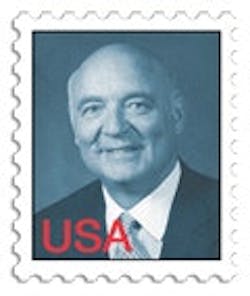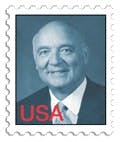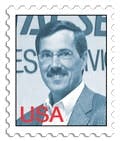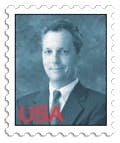The United States Postal Service Delivers
Can you imagine being one of 760 professionals responsible for over 35,000 facilities across the United States (that's about 46 facilities per person if your calculator isn’t handy)? How about working for an organization that has at least one building in every U.S. community?
These intimidating figures are merely common practice for the United States Postal Service’s (USPS’s) facilities department. The sheer size of this government giant is a trait that sets it apart from any other organization: “We’re a unique animal,” says Rudy Umscheid, vice president of facilities, Arlington, VA. The USPS delivers mail to over 142 million homes, businesses, and post office boxes; serves more than 7 million customers daily; and delivers over 206 billion pieces of mail each year. “The USPS is being judged every day by how timely they’re delivering the mail. They need us to support that mission by having the space and work environments to do their jobs,” explains Umscheid. “And in the same way the operations folks deliver your mail every day, on time - in facilities, we deliver spaces and services for them every day, on time.”
There are eight USPS Facilities Service Offices (FSOs) strategically located across the country, reporting to Facilities Headquarters in Arlington, VA, for functional guidance and policy establishment. Each FSO has a “manager” who works with the operations staff (the group responsible for processing and delivering mail) and is an integral part of the area’s management, headed by an area vice president. FSO managers serve a specific region, with responsibility for an average of 4,500 facilities, and perform various functions: fulfilling space needs, optimizing building usage, keeping on top of maintenance, taking care of leasing requirements, addressing environmental issues, pursuing development opportunities, working with communities on the location of all new post offices, etc. At headquarters, it’s Umscheid’s responsibility to provide leadership, address complex issues, and secure necessary approvals. As the vice president of facilities, Umscheid reports to the senior vice president of operations, who ultimately reports to the USPS’ deputy postmaster general/chief operating officer. “Our organizational structure gives authority and responsibility to our managers to meet the expectations of their internal customers; it’s a culture that empowers our professionals to be proactive and entrepreneurial,” emphasizes Umscheid.
Title: Vice President of Facilities
Location: Arlington, VA
Years of service: 11.5
Responsible for: Overall design/construction and real estate
The department is nationally recognized and best-known for its commitment to sustainability and energy-efficient design; you can’t talk USPS facilities without talking green. Due to its large construction program, the USPS chooses to take a proactive approach to constructing green buildings. “We are providing our customers and employees a healthy indoor environment, and we are setting a standard for others to follow. Many green building features have an excellent return on investment, especially when life-cycle costs are considered,” explains Umscheid. “With the size of our program and the possibilities with energy efficiency and sustainable features, we could see the benefits to the organization.” Buy-in from upper management is achieved by touting this return on investment via enhanced building durability, energy and water savings, and reduced maintenance costs.
Title: Manager, Design and Construction
Location: Arlington, VA
Years of service: 13
Responsible for: Design/construction of all major facilities, rollout of design/construction programs coordinated from headquarters, building design policies/standards
With a goal of not exceeding construction costs by more than 10 percent above standard project costs, the USPS tests sustainable strategies on “showcase projects” to see which ones are successful. One such project is a USPS straw bale facility, located in Corrales, NM. “That, of course, was a strategy that we weren’t testing to necessarily incorporate into a standard, because it’s simply not possible to do that everywhere,” explains Ujwala Tamaskar, manager, design and construction, Arlington, VA. “The first showcase project completed was 8th Avenue Station in Fort Worth, TX. In that project, we tested numerous initiatives: full-spectrum artificial lighting, low-VOC paints, hoop-and-loop carpeting, and other products that contribute to healthy interiors - materials with recycled content, materials with alternative agricultural products, and energy-efficient materials and systems. We tested rainwater harvesting as well. This was not something we were planning on incorporating into our standard, but with the showcase project deployed, we wanted to try it out. There were several other items that we felt a little bit more comfortable with that we included in our national building design standards.”
Challenging all FSOs to construct a project using some of these green features, the USPS collected data after completion and tracked the projects, taking note of which features were successful. “There were some that were successful; there were some where the results clearly meant that this was not something we could do on all our projects,” says Tamaskar.
But size and sustainability aren’t the only reasons this facilities department is different: In the face of financial constraints and limited resources, the team has put together efficient techniques for managing a complex and large-scale portfolio - best-practice methodologies and forward-thinking procedures that allow them to meet challenges head-on.
THE CHALLENGE: So many facilities, so little time.
THE SOLUTION: Building design standards.
With an objective of reducing design time and guesswork, the USPS issues building design standards annually. This collection of design criteria, standard plans, and specifications is applicable to new construction, repairs/alterations, expansions, and additions to customer service and processing/distribution facilities. Based upon facility size and type, delivery methods, and leased vs. owned facilities, the standards allow for all scenarios. “There is a deviation process which addresses anomalies of projects where a slight variation is needed. For example, these standards don’t dictate the exterior - that’s something that the project manager addresses based on the surrounding architectural environment,” says Tamaskar. A feedback system facilitates the opportunity for the standards to be updated and improved; those revisions are incorporated on an annual basis. Legal obligations such as accessibility, and innovations such as automated postal centers that change lobby designs, are easily incorporated into USPS facilities through these design standards. “Design standards help to standardize the consistent appearance and brand identity we want for the customer service lobbies. Standards are either somewhere between 10- to 90-percent complete based upon the size and type of the facility, so for individual projects, this helps us reduce the design time and the guesswork of deciding what exactly needs to go in,” Tamaskar emphasizes.
Reducing energy consumption by 20.5 percent since 1985, energy efficiency has long been a consideration for the USPS. Initiating a sustainability program in 1995, the team performed a thorough review of its building design standards specifically for energy-efficiency and sustainability features. Several innovative practices that were tested in showcase facilities were later incorporated into these design standards.
THE CHALLENGE: Tighter budgets, limited capital.
THE SOLUTION: Space prioritization system. Disposition of excess properties protocol.
Title: Manager, Facilities Program Management
Location: Arlington, VA
Years of service: 28
Responsible for: Overall facilities program management responsibilities
“Since 2001, we’ve had a reduction in capital spending in the area of new space projects,” explains Jae Pak, manager, facilities program management, Arlington, VA. “We maximized the budget that was provided for new space programs by developing a new space prioritization system. Previously, each area was provided a budget for its new space projects. As funding became limited, we determined the best way to maximize those dollars was to develop a national prioritization system, because what turns out to be a high-priority project in one area could be a medium- or low-priority project in another area. We wanted to make sure that we took care of the most critical needs first. We had approximately 540 new space requirements submitted last year, and out of those - because of our budget - only 280 projects made the list,” says Pak. The team invited the operations staff in each region to submit space needs, asking them to fill out standard documents to identify space deficiencies, safety issues, etc. Facilities Headquarters collected and reviewed the documents, and prioritized them using five main criteria: 1) severe space deficiency; 2) safety; 3) lease preemption [a lessor terminating or not renewing a lease]; 4) high-growth areas [such as Las Vegas, Phoenix, and Atlanta]; and 5) generative projects [occasions where another organization wants an existing post office due to its location and is willing to pay high dollars or provide a replacement facility to obtain the existing facility].
Another process in place is the protocol for disposing of excess properties. As operations staff moves out of USPS-owned properties that the organization determines are no longer needed, it sells them. “If they’re small post offices, there’s a very straightforward disposition process that allows people, private investors, or developers in a community to buy them,” explains Umscheid. “Whenever there’s a municipality in an existing building, we work with the municipality and developers to position the building in the market and secure the necessary entitlements. We’ve been working for almost 10 years with New York City so it can acquire the James A. Farley Building. They want to transform it into a train station. If we think our property can be put to a higher and better use, but will still fulfill our needs, we will work with a community. St. Paul, MN, has an old property downtown on the river. The city would like that for redevelopment of the waterfront. We say, ‘Great. If you can help us find another property and help us replace it so it makes economic sense, we’d be glad to engage you in a good-faith negotiation.’ We do that as a matter of policy. Because we’ve had more flexibility than other agencies, I’d say that we’ve always been on the cutting-edge in terms of these types of transactions.”
THE CHALLENGE: Fewer people, heavier workload.
THE SOLUTION: Response line. Facilities Single Source Provider program.
Title: Manager, Eastern FSO
Location: Greensboro, NCYears of service: 19
Responsible for: Design, construction, repair, and leasing of 8,700 buildings in Eastern and Capital Metro regions
Working day in and day out with local operations staff and postmasters, FSO managers established a response line for every post office nationwide. With anywhere from 200 to 1,000 requests coming in per week for an individual office, this toll-free number records requests in a Web-based system, and each request is assigned to the project manager for that particular area. “We have complete visibility of every single call and every single problem that’s recorded, and anyone within the Postal Service can also look at it so they can track the progress of their problem - who’s taking care of it, when it was taken care of, and what the resolution was,” explains Thomas Russell, manager, Eastern FSO, Greensboro, NC. Once the project manager marks the request as “complete,” an e-mail is sent to the requestor with a five- or six-question customer satisfaction survey; any review below a certain score is investigated. “It’s all part of our culture here - it’s more quality-based instead of quantity-based,” explains Michael Goodwin, manager, Southeast FSO, Lawrenceville, GA.
The facilities team agrees that the response line has streamlined processes, but they’re not settling for good enough. “The response line is a very effective tool for us. The call comes in, we assign a project manager, and the work gets done. The downside of it is that it makes it difficult for budgeting, because it’s a pretty reactive system,” says Goodwin. To manage this concern, Pak is currently driving a new building inspection program that will allow FSO managers to inspect buildings on a regular basis, identifying deficiencies and prioritizing work that needs to be done. The goal? To build more project-specific budgets for each facility.
Title: Manager, Southeast FSO
Location: Lawrenceville, GA
Years of service: 18
Responsible for: Design, construction, repair, and leasing of 4,000 facilities in Southeast region
FSO managers also make it a priority to keep internal customers up-to-date on portfolio status. They attend meetings; give presentations on how much work is being done in the region, how much is being spent, and how much is backlogged; and provide a snapshot of the portfolio compared to other USPS regions. “As the facilities organization, we understand more and more that we have a larger role to play in helping the USPS operation be successful,” says Goodwin.
Wanting to streamline processes in a system with no consistency in terms of how facilities projects were handled, the USPS also developed its Facilities Single Source Provider program 4 years ago. “Some districts were very aggressive in their facilities program; some were very docile. The infrastructure was failing,” explains Russell. In consolidating all information for postmasters and operations staff in one place, regardless of the type of work they were requesting - a roof leak, a plumbing clog, or a major building expansion - the system allows a single call to be made that will no longer be passed from one department to another.
Massive Mission
With the job of providing quality real estate and facilities products and services to meet the present and future needs of postal operations, the facilities team is responsible for planning, new construction, repairs/alterations, design, site acquisition, building expansion, real property disposal, developmental programs, and building inspections for:
- Customer service facilities (providing retail, post office boxes, and carrier operations).
- Carrier annexes.
- Retail centers.
- Processing and distribution centers.
- Air mail centers.
- Vehicle maintenance facilities.
- Training facilities.
- Warehouses.
- Office spaces.
- Parking facilities.
The program was established, and the team is now yielding a lot more work with a lot fewer resources. “Most importantly, we’re now able to track every single project that’s done, regardless of the dollar value - from a $50 hardware fix to a multi-million-dollar new building. Before, we didn’t have that central database of all the work. I can go to my customers and tell them where they are financially, how they compare to other districts, how to forecast, what we should forecast for the remaining months: The postmasters love it,” says Russell. This data-driven system is based on pure statistics in terms of how many calls are received, the number of problems and how long it takes to fix them, the dollar value, and how the customer satisfaction was rated. “It’s centralized, and it’s transparent to the world. It’s no longer that someone sends a request in and doesn’t know what’s happening to it. Anybody within the Postal Service can look at any call, any time, and know exactly what’s happening. We no longer hide behind an excuse of why it’s not getting done - it’s visible to everyone,” Russell points out.
“We’re looking at processes: Can we cut times in half; can we cut the number of people who get involved and touch a process? Can we be more like Wal-Mart - drive by and stick our head out the window and say, ‘That’s our site. Go for it’? We’re working in that direction, but we’re not there yet,” says Umscheid. “We’re giving the staff less money and fewer people to do more work. Technology has been a big, big reason why we’ve been able to crank out and produce more work with fewer people, and been more consistent and more reliable in what we do.”
The Big Picture ...
| Annual Averages For ... | Completed | Current Projects |
| New construction (owned): | 260 | 381 |
| New construction (leased): | 275 | 89 |
| Alternate quarters: | 215 | 71 |
| New leases: | 2,500 | N/A |
| Lease renewals: | 2,400 | N/A |
| Repair/alteration projects > $250,000: | 698 | N/A |
| Repair/alteration projects < $250,000: | 9,599 | N/A |
| Building purchases: | 96 | 13 |
A common predicament for many organizations today, the USPS is also facing a future that involves a shrinking bench of managers. Recruiting for the long term, Russell explains that anyone they hire now must have the longevity potential to become an employee working in the field for the next 15 or 20 years. “We’re looking for the future project managers and leaders of the office,” he says. “As we go out and recruit, that’s exactly what we’re looking for. We really focus on building the future. We’re on that cusp; up until now, retirement hasn’t been a major issue.” Now, the team is investing in younger workers who will be able to demonstrate longevity. “When we show them where we came from and where we are now, [we show them that] there’s a career path in this organization. You can go as high as you want to - as high as you’re willing to put yourself into the work,” says Russell. While it is nerve-wracking, the team is also excited about upcoming opportunities: “We’ve had some new hires - new, young, energetic people,” says Goodwin. “The energy they bring - no bias toward the way things need to be done - it’s actually very refreshing.”
The USPS facilities department is a customer-focused organization, utilizing the latest technology and management skills to optimize its performance, which is constantly being re-evaluated to ensure progress. Today, the team is being held more accountable for its performance and contributions to the Postal Service than ever before - and they're succeeding.
Leah B. Garris ([email protected]) is associate editor at Buildings magazine.





